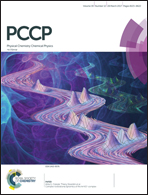On the calculation of second-order magnetic properties using subsystem approaches in a relativistic framework†
Abstract
We report an implementation of nuclear magnetic resonance (NMR) shielding (σ), isotope-independent indirect spin–spin coupling (K) and the magnetizability (ξ) tensors in a frozen density embedding scheme using the four-component (4c) relativistic Dirac–Coulomb (DC) Hamiltonian and non-collinear spin density functional theory. The formalism takes into account the magnetic balance between the large and the small components of molecular spinors and assures the gauge-origin independence of the NMR shielding and magnetizability results. This implementation has been applied to hydrogen-bonded HXH⋯OH2 complexes (X = Se, Te, Po) and compared with supermolecular calculations and with an approach based on the integration of the magnetically induced current density vector. A comparison with the approximate zeroth-order regular approximation (ZORA) Hamiltonian indicates non-negligible differences in σ and K in the HPoH⋯OH2 complex, and calls for a thorough comparison of ZORA and DC Hamiltonians in the description of environment effects on NMR parameters for molecular systems with heavy elements.



 Please wait while we load your content...
Please wait while we load your content...